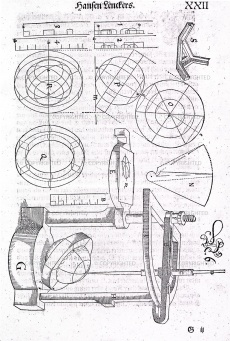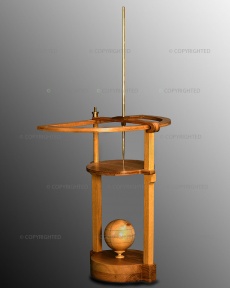Instrument for Orthographic Projections
From Inventions
| Line 7: | Line 7: | ||
|data= 1571 | |data= 1571 | ||
| - | |descrizione= The only sixteenth-century example of an instrument designed to draw complex bodies in orthogonal projection. It operates in the same way as Dürer’s [[window]]. The drawing board with the sheet of paper is initially outside the radius of action of the large vertical stylus which, moving along the radius and the semi-circumference of the upper frame, can touch any point on the object placed at the base of the instrument. When it has touched the point to be drawn, the stylus is raised, the drawing board rotated to interpose it between the stylus and the object, and the stylus lowered again to trace the point on the paper. The stylus is, in fact, the materialization of one of the infinite parallel rays serving to construct an orthographic projection. The fact that the object represented is a globe suggests that the instrument was designed within the context of the debate on orthographic projection that arose among astronomers in connection with the construction of the universal planisphere. In this debate Lencker, given the context of his treatise, seems to share the interpretation of Gemma Frisius and Juan de Rojas who, in contrast to Guidobaldo del Monte, considered orthographic projection as a perspective projection with the eye placed at an infinite distance. The instrument was later modified by Johannes Faulhaber to be used for drawing bodies in isometric projection (1610). | + | |descrizione= The only sixteenth-century example of an instrument designed to draw complex bodies in orthogonal projection. It operates in the same way as Dürer’s [[Door |window]]. The drawing board with the sheet of paper is initially outside the radius of action of the large vertical stylus which, moving along the radius and the semi-circumference of the upper frame, can touch any point on the object placed at the base of the instrument. When it has touched the point to be drawn, the stylus is raised, the drawing board rotated to interpose it between the stylus and the object, and the stylus lowered again to trace the point on the paper. The stylus is, in fact, the materialization of one of the infinite parallel rays serving to construct an orthographic projection. The fact that the object represented is a globe suggests that the instrument was designed within the context of the debate on orthographic projection that arose among astronomers in connection with the construction of the universal planisphere. In this debate Lencker, given the context of his treatise, seems to share the interpretation of Gemma Frisius and Juan de Rojas who, in contrast to Guidobaldo del Monte, considered orthographic projection as a perspective projection with the eye placed at an infinite distance. The instrument was later modified by Johannes Faulhaber to be used for drawing bodies in isometric projection (1610). |
|componenti= | |componenti= | ||
Current revision as of 12:06, 27 July 2010
Has no specific name.
Contents |
Inventor
Hans Lencker (?-1585)
Historic Period
1571
Description
The only sixteenth-century example of an instrument designed to draw complex bodies in orthogonal projection. It operates in the same way as Dürer’s window. The drawing board with the sheet of paper is initially outside the radius of action of the large vertical stylus which, moving along the radius and the semi-circumference of the upper frame, can touch any point on the object placed at the base of the instrument. When it has touched the point to be drawn, the stylus is raised, the drawing board rotated to interpose it between the stylus and the object, and the stylus lowered again to trace the point on the paper. The stylus is, in fact, the materialization of one of the infinite parallel rays serving to construct an orthographic projection. The fact that the object represented is a globe suggests that the instrument was designed within the context of the debate on orthographic projection that arose among astronomers in connection with the construction of the universal planisphere. In this debate Lencker, given the context of his treatise, seems to share the interpretation of Gemma Frisius and Juan de Rojas who, in contrast to Guidobaldo del Monte, considered orthographic projection as a perspective projection with the eye placed at an infinite distance. The instrument was later modified by Johannes Faulhaber to be used for drawing bodies in isometric projection (1610).
Bibliographical Resources
Lencker, Hans, Perpectiva hierinnen auffs kürtste beschreiben…, D. Gerlak, Norimberga 1571.
Faulhaber, Johannes, Mathematici tractatus..., Francoforte 1610. p. 38.
Existing Instruments
Firenze, Museo Galileo-Istituo di Storia della Scienza, modello funzionante, 2001.
Images
Author of the entry: Filippo Camerota



